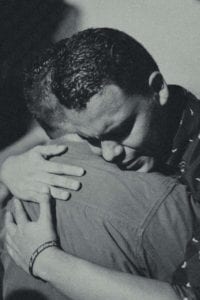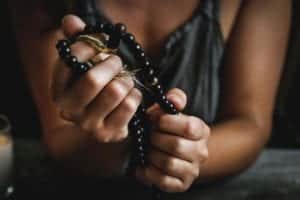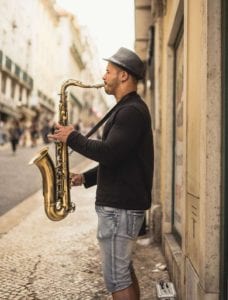8 WAYS TO PRAY WITHOUT WORDS
 How many words does it take to make prayer effective? If language fails you in a moment of prayer, here are 8 ways to pray without words.
How many words does it take to make prayer effective? If language fails you in a moment of prayer, here are 8 ways to pray without words.
Regardless of whether there was religion in our upbringing, we all have some experience, or expectation of, prayer–if not a complete repertoire of the rules. Before eating. At bedtime. In sickness. On your knees or with a bowed head. With music. In silence.
But why? Why are there so many ways to pray, and so many ‘rules’ to follow? How did we get to this place of spoken prayers anyway? Is there another way to pray that doesn’t call us to be eloquent with language?
The first prayer I ever learned was, “Now I lay me down to sleep…” followed by a lullaby in which a baby in a cradle falls out of a tree.
I spent the better part of my childhood wondering if I would die before I woke up. Of course, it was written at a time when infant mortality was a lot higher than it is today, and death was always on the minds of the parents as they tucked their babies in for the night. (Photo by Fabian-Gieseke on Unsplash)
RIGHT AND WRONG WAYS TO PRAY
The older I got, the more I learned about the ‘theology’ of prayer…and the ‘right’ words and gestures to use. I come from a Christian liturgical tradition, but as I explored other customs, I noticed that there are right ways and wrong ways to pray in all of them.
I love the instruction of Cyrus Brown when it comes to prayer. I shared this poem in a previous post – “Is There a Right Way to Pray“, and it bears repeating.
“The proper way for a man to pray
Said Deacon Lemuel Keyes,
“And the only proper attitude
Is down upon his knees.”
“No, I should say the way to pray,
Said Rev. Doctor Wise,
“Is standing straight with outstretched arms
And rapt and upturned eyes.”
“Oh, no; no, no,” said Elder Slow,
“Such posture is too proud:
A man should pray with eyes fast closed
And head contritely bowed.”
“It seems to me his hands should be
Austerely clasped in front.
With both thumbs pointing toward the ground,
Said Rev. Doctor Blunt.
“Las’ year I fell in Hodgkin’s well
Head first,” said Cyrus Brown,
“With both my heels a-stickin’ up,
My head a-pinting down;
“An’ I made a prayer right then an’ there
Best prayer I ever said,
The prayingest prayer I ever prayed,
A-standing on my head.”
(The Prayer Of Cyrus Brown by Sam Walter Foss)
I understand Cyrus Brown being absorbed in the ‘right way to pray”. Been there. Done that. In the end, we see him plunging headfirst into a well, and I can almost hear him now – “AAaauURRrrgHo…O…o…ow…wwww…”. Not sure he used any real words at all!
After he prayed the ‘prayingest prayer’ he ever said, a poem was written about it, so it appears his plea was heard. Note that Cyrus’ prayer was a ‘body prayer,’ an expression from his entire body, not from his inquiring mind. Without words and no time to think of them, Cyrus’s plea was quite clear.
It is from’ Cyrus Brown’ that I first began to understand a ‘prayer without words and rules’ may be the most crucial prayer there is.
HERE ARE 8 WAYS TO PRAY WITHOUT WORDS
Note that they all employ the body.
1. A Hug.
 When there are no words to bring solace, and recitation of learned or printed words isn’t going to cut it, what then?
When there are no words to bring solace, and recitation of learned or printed words isn’t going to cut it, what then?
A hug in which we wrap our arm around someone in a warm embrace may be the most powerful prayer of the moment.
It says, “Fear not. You are held. You are safe. You are loved.” The energy of that moment vibrates out into the Universe and healing begins. An alternative to this is holding someone’s hand in silence. (photo by Josue-Escoto on Unsplash)
2. Beads.
 People made and used prayer beads for many thousands of years in various cultures and religious traditions.
People made and used prayer beads for many thousands of years in various cultures and religious traditions.
Although some people practice recitation of learned prayers with each bead, words are not necessary.
When I sit with beads, slowly drawing them through my fingers, names, and faces move through my imagination as I inhale and exhale with each bead. (Photo by Chelsea-Shapouri on Unsplash)
Nothing is said. It isn’t needed. Just sitting and watching the parade go by, each person is welcomed in openness of heart, and anointed by love
3. Music.
 Music without words can communicate as much or more than a ballad or chorale just through the rhythm and vibrations. (Photo by Daniel-Angele on Unsplash)
Music without words can communicate as much or more than a ballad or chorale just through the rhythm and vibrations. (Photo by Daniel-Angele on Unsplash)
Wordless prayer goes forth whenever we hum, drum, or noodle on a musical instrument. I am not talking about practicing or performance. That has its own chorus of voices in a professional musician’s head. But if you just surrender yourself to whatever your instrument wants to say, you can leave behind the voices that continuously chime in with judgments.
There is a place for mindless rhythm, with or without harmony, a beat that carries our innermost yearning and unspoken prayers into the Universe.
4. Art.

I happen to be too left-brained to ‘lose’ myself in painting, but I have made profound prayers through a process called Soul-Collage and also through Zen Tangling. In this latter practice, I write names or situations on a piece of paper and draw repeated patterns around each. When complete, I have spent more time ‘praying’ than I ever could have with words. (Photo by krV5aS4jDjA On Unsplash)
5. A shower.
 No, I haven’t lost it.
No, I haven’t lost it.
There is something about water, either from the shower or perhaps walking in the rain, that refreshes and renews the spirit as well as the body. It holds the practice of repentance and forgiveness in every drop.
Cleansing and refreshing, it is a prayer where two words seem to ‘leak’ out with the water. “Thank you.” (Photo byPradidpong on Unsplash)
6. Walking.
The thing about walking as prayer is that it engages the whole body with each step. Muscles, eyesight, hearing, aromas–if I am mindful of all the sensations my body feels as I walk, then my thinking brain can sigh and surrender worries, judgments, and problem-solving.
I often walk through my community in the early morning. As I pass by each home, I know not what trials and sorrows are behind every door. But I can hold each unknown occupant in my lungs as I breathe.
Inhaling struggle and chaos, exhaling grace and peace. My walks, which could be all about my own exercise needs, have become unspoken prayers for a world hidden behind walls. Exercise is a welcome bonus.
7. Breathing.
 When in the Bible, we read “Pray without ceasing,” the only way I know how to do this is to let my breath be my prayers.
When in the Bible, we read “Pray without ceasing,” the only way I know how to do this is to let my breath be my prayers.
Whether we are breathing in and out with prayer beads sliding through our fingers, or along with each step we take through the neighborhood, breathing is ‘unceasing’.
What does cease are our distractions, which leave us free to surrender this process to the needs of a broken world. (Photo by Elijah-Hiett on Unsplash)
8. Sleep.
 Sleep calls us to surrender to the Unknown in a way that nothing else can. When we lie down in darkness we do so trusting that our breathing and heartbeat will continue.
Sleep calls us to surrender to the Unknown in a way that nothing else can. When we lie down in darkness we do so trusting that our breathing and heartbeat will continue.
Our brains enter a process of integration of the day we just lived with our hopes and struggles that lie ahead. (Photo by Kate-Stone on Unsplash)
We snore through the entire ‘prayer’ until we awake in the morning with an awareness that ‘something’ has gone on in the night.
Neuroscientists study sleep but don’t have definitive answers for what that is. Our spirits communicate with Mystery each and every night. That is the essence of prayer!
The next time you are asked to ‘pray’ don’t hesitate for lack of words. Let your body ‘speak’ for you.


Ellen
Brought me back to my childhood and learning all the prayers in Catholic School. Which I can still say today without even thinking about it. So now I’m going to try some of the ways you suggest. I love the idea of beads.
Ardis Mayo
When I shared portions of this article in an evening service at church I swapped out ‘knuckles’ for beads. They work just as well, especially when out and about without any beads. Using the knuckles across the back of the hand (and finger joints) to pass through your fingers the same way as beads, letting concerns and or people parade through our hearts and on into the Universe. And we always have knuckles!!
Nancy Emanuel
What a lovely article Ardis. I really enjoyed it!
Ardis Mayo
Thank you, Nancy. May the words that speak to you enrich and sustain your prolific writing/blogging.
Della Gleason
Ardis,
I am one of those folks that doesn’t usually volunteer to lead a prayer because I’m afraid I won’t find the right words. Thank you for showing that prayer can take various forms.
Ardis Mayo
You are welcome, Della. May you find a way to listen/communicate with Mystery that fits with who you are and the language you ‘speak’ – without words.
helen Willey
All these keep us in continuous prayer. Helen
Ardis Mayo
Spoken as woman of unceasing prayer.
Rita Poirier
Somewhere in my childhood I decided I had to talk to pray in complete sentences. Silently thinking those words was fine, but it had to be a whole sentence, mentally spoken. Things we learn as kids can be really hard to shake. Articles like this, and the passage of time have allowed me to finally loosen my grip on that practice, but I still have to work at. Thanks for the reminder that there are many ways to reach out to God, and they are all “right.”
Ardis Mayo
Yes. ‘Right’ is what ‘right’ does, Rita. The prayers we learn as a child certainly do reside in our tissues and when life gets too stressful for anything else, they pop up as surely as a knee jerks when hit by a hammer. This is good. Perhaps the message here is to practice prayer of any sort until it it becomes rooted in us and blooms when we need it to.
Judith Scarborough
Thank you for this reminder of different ways of praying. Long ago, when I first saw the film version of “Fiddler on the Roof,” I remember being struck by the Fiddler’s conversations with God, and how his prayer came out of his life’s needs and joys at the moment. Even as a teenager, unschooled in theology, I accepted this way of praying, and have relied more on conversations than formal prayers. At this time, I am exploring ways of meditation, and trying to listen to God, with varying degrees of success. I will keep your suggestions in my heart as I navigate my prayer life. Blessings!
Ardis Mayo
I think the key word you used, Judith, is ‘conversation.’ And all conversation has at least 50% listening. I find listening prayer to be what brings me closest to a sense that I am not all alone in this thing called life.
Bonnie
Another lovely affirmation of the breadth of Mystery. Your suggestions around prayers and the myriad of ways we can offer them feels like taking off a tight girdle (does anyone actually wear those anymore?) and relaxing into the shape we are. Thank you.
Ardis Mayo
I so love your image of a tight girdle!! I remember them with a smile. So glad to relax into reality–both in prayer as well as in body. Thank you for the image.
Terrie
Love the ‘short and sweet’ ideas. It reminds me of one of my favorite books “Pray Always” by Edward Hayes (A contemplative priest) I think it’s important to make our whole life a prayer and your article this week presents this beautifully. I will post it on my OBSERVE page again. Many Blessings Ardis.
Ardis Mayo
I certainly appreciate it when you share with your audience, for we speak with similar voices.
Grace Bartlett
Ardis, “8 Ways to Pray Without Words” speaks to my experience. These are sanctuary or holy places for me. Thank you for sharing this. Blessings.
Ardis Mayo
Holy Places are so readily available and we so often think we have to go somewhere special. Thanks for pointing this out and also for the blessing.